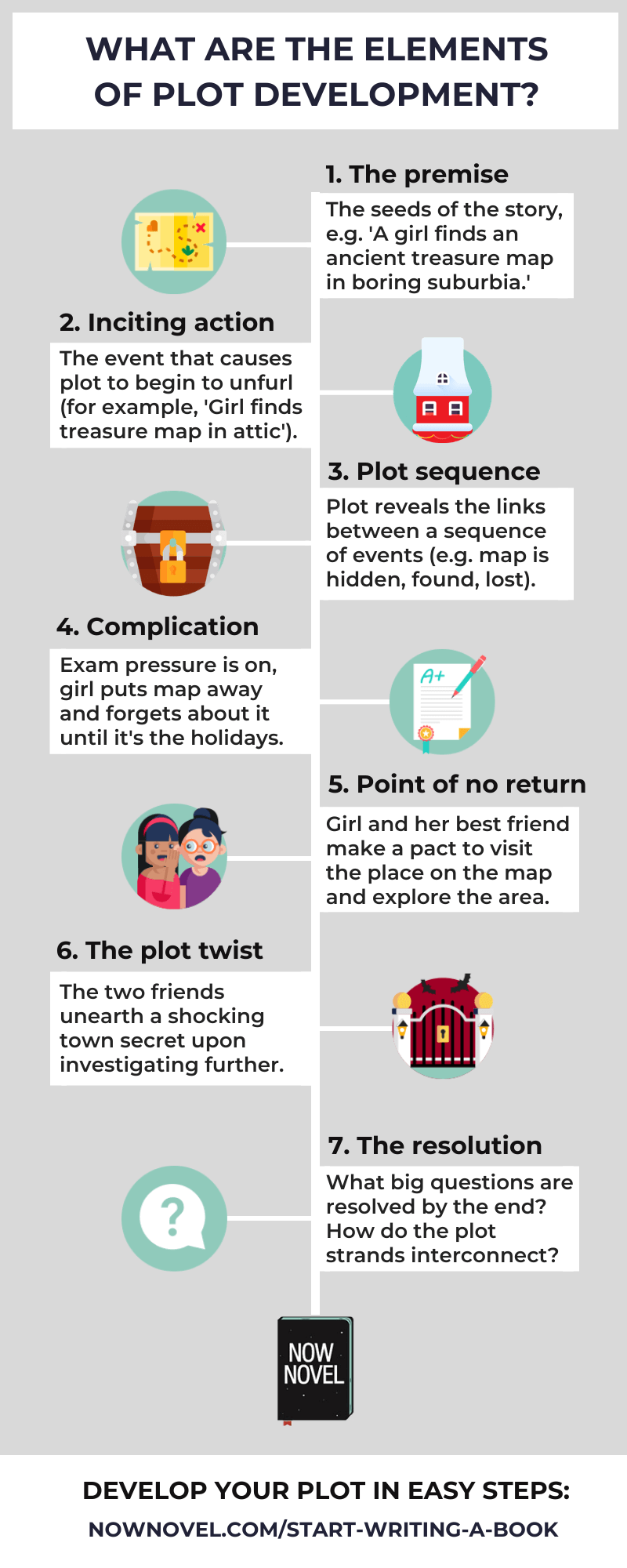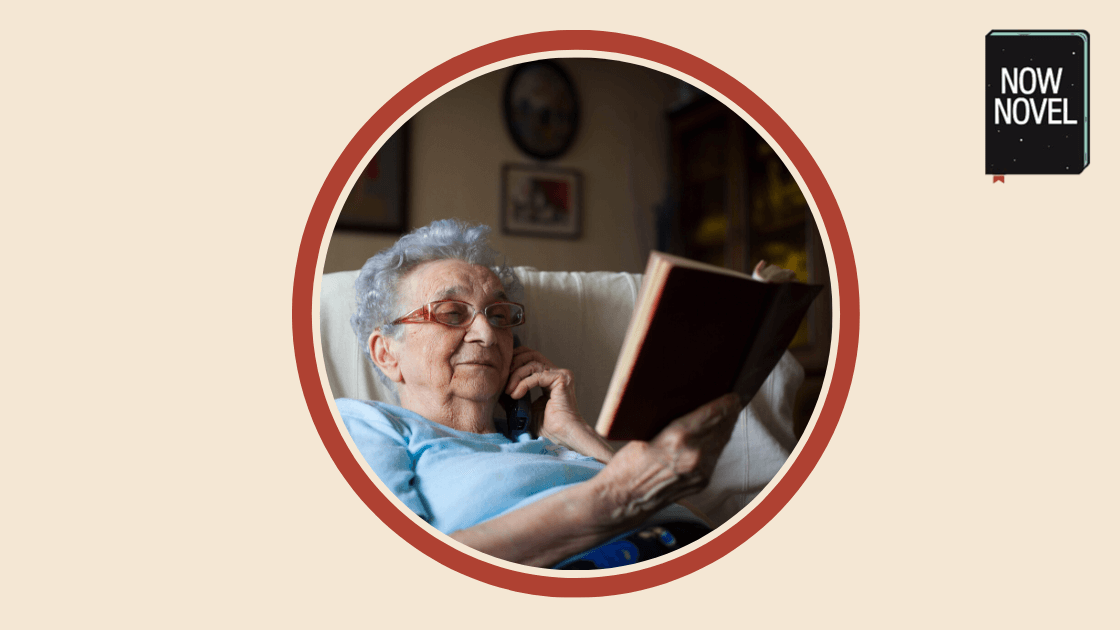What are the elements of plot development to remember when crafting a story? Read about 7 key elements of plot:
1. The premise (or story scenario)
The premise or scenario is the situation or concept on which we build a story. Take a logline for a popular novel, such as John Grisham’s The Reckoning (2018):
A decorated World War II veteran shoots and kills a pastor.
The premise sums up the key situation the story explores and unpacks.
A summary like this is a great foundation for plot development. It limits what could possibly happen, by defining a time (after World War II), characters (military and church figures) and a key event or turning point (a shocking killing).
A good premise enables us to start asking questions and develop plot. For example:
- Why did the veteran shoot the pastor?
- What does the vet do next?
- How does the community react?
- What does World War II and the vet’s past have to do with this action?
A premise fires our imagination by leaving many possible questions unanswered. [Develop a strong premise using our story outlining prompts.]
2. The inciting action or event
Plot is defined as ‘the main events of a play, novel, film, or similar work, devised and presented by the writer as an interrelated sequence.’ (Lexico, via Oxford Dictionaries).
How do we begin exploring an ‘interrelated sequence’, the connected events of a story? Something happens. When this event sets the story in motion, narrative theory calls it the ‘inciting action’ or ‘inciting event’.
The event ‘incites’ further action or plot development, the way the first rock thrown incites a riot.
Examples of inciting events:
- A military veteran smuggles a gun into his church (a hypothetical inciting event for Grisham’s novel)
- A man extinguishes all the street lights on a suburban street so he can leave a baby on a doorstep in the dead of night (the first book of J.K. Rowling’s Harry Potter series)
- A man watches a young woman busking for tips in a public park, and feels his heart ‘shatter’ (Harlan Coben’s Run Away (2019))
Coming up with an inciting event creates further fodder for plot development. It turns the broad situation of a premise into the concrete action of story development.
Good inciting action is a useful element of plot development because:
- It introduces characters in interesting settings and situations, often at a key moment of choice or change
- It leaves room for further questions (questions of who, what, why, where and when)
3. The connected sequence
What are the elements of plot development that make a story satisfying?
One is the ‘connected sequence’ of events.
If you’ve ever read a beginner’s story where it seems random events happen ‘just because’, you’ll know how frustrating this is. We become unsure why the author is sharing this or that event. The significance of events – the reason behind their sequence or juxtaposition – is unclear.
Writers sometimes avoid making obvious connections, of course. This is a valid approach to plot – making plot not particularly important. Even so, many readers desire clear cause and effect.
When the military veteran kills a holy figure, readers want to know the connected sequence that lead to this shocking act. It’s the ‘Why?’ we ask from a young age, wanting to understand.
‘Why?’ is the single most useful question for developing a plot that feels connected and cohesive.
Take this scenario: A man catches a train from Porto, Portugal to Madrid, Spain. Yet he never reaches his destination and there’s a massive manhunt.
You could develop the skeleton of a plot by asking why:
- Why does the man catch a train to another city in another country?
- Why does the man disappear?
These two questions could in turn spawn many answers. Answers that further spur plot development. For example, answering the first question:
- Because all flights between Porto and Madrid have been grounded temporarily
- Because it’s cheaper than flying and the man has just lost all his money
For the second:
- Because the man never actually intended to reach his destination, but wanted it to look as though he’d left
- Because the train was diverted mid-journey
By making the character take a long-distance train, we set a limit to what can happen next. We create the possibility of a connected event too – something happens to do with the man’s mode of transport, or his intentions behind catching a train.

4. The interruption, delay or complication
One of the useful elements of plot development at our disposal is the ‘interruption’.
There are many ways you can interrupt the flow of your narrative to complicate how your plot develops. For example:
- Switching to another central character’s viewpoint for a chapter interrupting a first character’s arc.
- Inserting a smaller event that sidetracks a character from a primary goal.
Take, for example, Odysseus’s journey homewards after the Trojan War in Homer’s Odyssey. Odysseus’s return is urgent: Suitors are nagging his wife to pick one of them, claiming Odysseus must be dead.
There are all kinds of delays and disruptions to Odysseus’s homewards journey that complicate the plot, delaying a key event (Odysseus’ homecoming).
For example, Odysseus’s crew mates on his ship are turned into swine by an enchantress, Circe, on an island, and Odysseus sets out to rescue them, guided by the Gods.
As you develop your story, think of side-plots or side-quests (if writing a quest-like story such as a detective or adventure novel) that can delay other plot points that still need resolving.
5. The point of no return
A ‘point of no return’ isn’t a feature every plot necessarily has. Yet it’s a useful concept for thinking about situations in which there is no going back. These propel plot forwards, sustaining forward momentum.
For example, in a spy novel, a point of no return could be the moment the main character agrees to become a double agent, serving both her own country and pretending to serve the enemy.
Once entangled in this double-dealing, there’s no easy way out. The double agent could defect to the enemy and invoke her original teams’ wrath. Or she could reveal or let slip her spying and become endangered while in the dangerous hands of the enemy.
This is a simple example of a point of no return. Yet there are all kinds of greater and smaller versions of this. The moment a teen agrees to take the lead in the school play, for example. The moment a teacher accepts a new post at a school notorious for rowdy and even dangerous students.
In developing your plot, think of events that mark the moments where characters make choices it won’t be easy to go back on.

6. The plot twist
Some genres are more likely to have dramatic plot twists than others. In thrillers, courtroom dramas and detective novels, they’re common. Because the idea of uncovering the truth – and the surprises that often emerge along the way – is embedded in these genres.
A good plot twist is unexpected.
For example, in Dickens’ Great Expectations, the reader has little inkling the mystery benefactor who leaves Philip (AKA ‘Pip’) enough wealth to make him a gentleman overnight is a random secondary character, rather than the obvious choice, the wealthy Miss Havisham (who Pip assumes is his benefactor).
If you want to create a good plot twist, ask:
- What plot explanations may the reader have assumed? (For example, that Pip becomes wealthy due to Miss Havisham’s surprising generosity in Great Expectations)
- What other explanations could there be for this plot development?
- How will you reveal the surprising truth to your reader?
7. The resolution
Plot development doesn’t necessarily lead to a tidy resolution. Some stories (particular in serial TV shows) end on maddening, cryptic situations where everything comes down to how the reader (or viewer) interprets events.
Even so, good plot development takes us to some kind of answer to the primary questions established by the premise.
For example, for the Grisham example above, by the end of the story we might know (or at least have a theory) why the military veteran shot the pastor.
In developing plot towards a resolution, ask:
- What are the biggest questions I haven’t answered yet?
- What are possible answers to these questions?
- How definite do I want my answer to be (do you want to leave enough lingering mystery, for example (as Lynch’s ending did) for a sequel or continuation?
Develop your plot with constructive critique from the Now Novel community. Or get detailed, private feedback from an experienced writing coach.


One reply on “What are the elements of plot development?”
Is it normal to do these plot developments subconsciously? I am trying to writer adventure thriller novels and I guess I have read some many (plus watched films) that the plot structure is ingrained in my head.